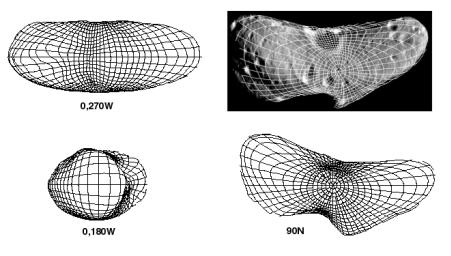
|
The Shape of Eros
- Click the image above for a larger view
- Full-Res JPEG (660 x 375) (58.1 kB)
- Full-Res TIFF (660 x 375) (52.1 kB)
Caption:
NEAR Shoemaker images provided the first model of Eros' shape, shown in this picture. An accurate model of Eros' shape helps the NEAR team determine the asteroid's key properties. The total space enclosed by the surface of the shape model represents the asteroid's estimated volume. The asteroid's mass (determined using NEAR Shoemaker's radio tracking) is divided by its volume to yield an estimate of its density - which is valuable for understanding what kind of rock makes up the interior. The shape also provides information about the distribution of mass below the surface, which scientists use to calculate surface gravity and thus the directions and steepness of slopes.
The positions of more than 2,000 landmarks on Eros were determined from more than 12,000 stereo measurements that generate a "grid" of points lying on the asteroid's surface. The shape model is a mathematical representation of the surface passing through all those points. The views at upper left, lower left and lower right show the shape model from over the equator (at 270 and 180 degrees west longitude) and the north pole (90north latitude), respectively. The shape model at upper right is overlain on an image acquired during approach to Eros.
Background Info:
Built and managed by The Johns Hopkins University Applied Physics Laboratory, Laurel, Maryland, NEAR was the first spacecraft launched in NASA's Discovery Program of low-cost, small-scale planetary missions. See the NEAR web page at http://near.jhuapl.edu/ for more details.
Cataloging Keywords:
| Name | Value | Additional Values |
|---|---|---|
| Target | 433 Eros | |
| System | Near Earth Objects | |
| Target Type | Asteroid | |
| Mission | NEAR Shoemaker | |
| Instrument Host | NEAR Shoemaker | |
| Host Type | Orbiter | |
| Instrument | Multi-Spectral Imager (MSI) | |
| Detector | ||
| Extra Keywords | Grayscale, Radio | |
| Acquisition Date | ||
| Release Date | 2001-02-17 | |
| Date in Caption | ||
| Image Credit | NASA/JPL/JHUAPL | |
| Source | photojournal.jpl.nasa.gov/catalog/PIA03113 | |
| Identifier | PIA03113 | |
